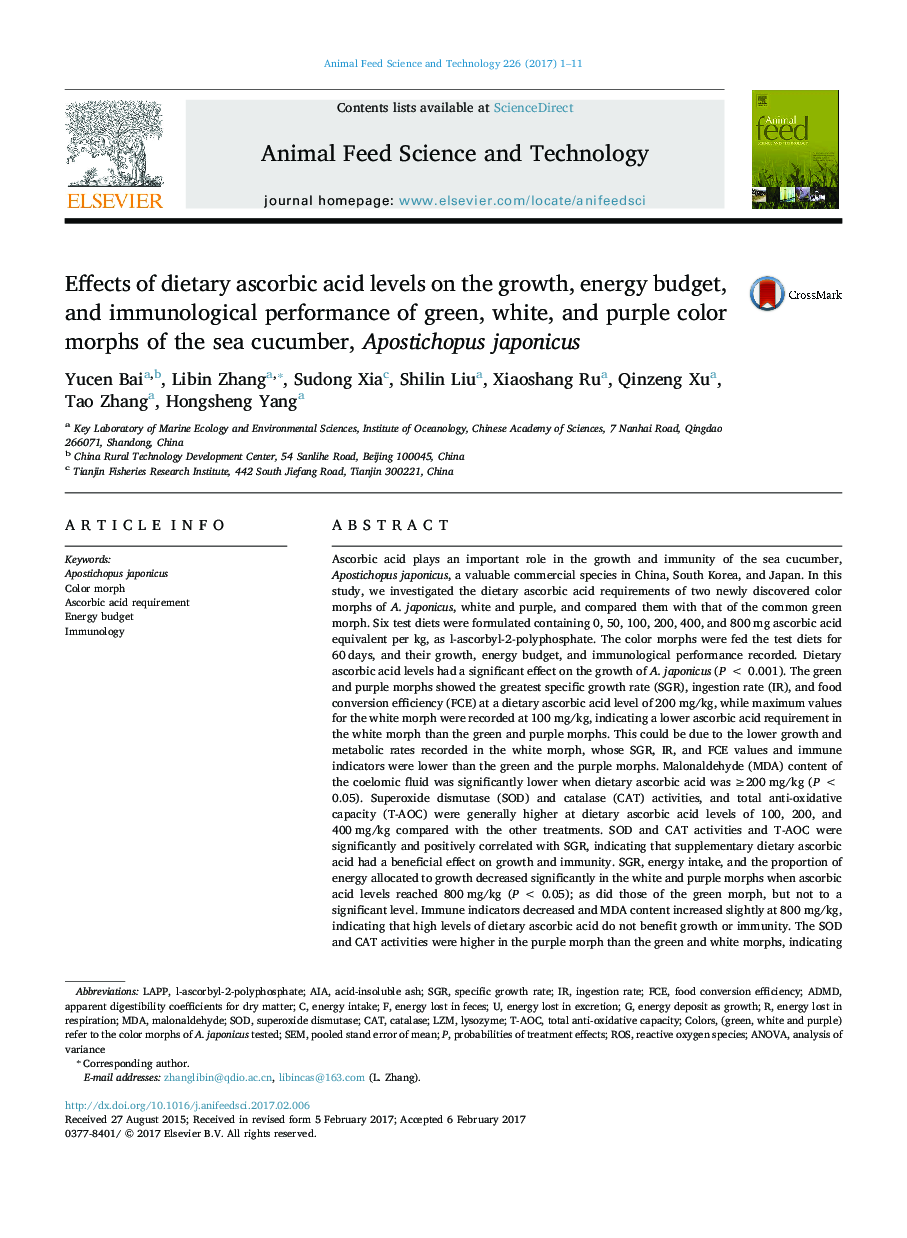| کد مقاله | کد نشریه | سال انتشار | مقاله انگلیسی | نسخه تمام متن |
|---|---|---|---|---|
| 5538899 | 1552360 | 2017 | 11 صفحه PDF | دانلود رایگان |
عنوان انگلیسی مقاله ISI
Effects of dietary ascorbic acid levels on the growth, energy budget, and immunological performance of green, white, and purple color morphs of the sea cucumber, Apostichopus japonicus
دانلود مقاله + سفارش ترجمه
دانلود مقاله ISI انگلیسی
رایگان برای ایرانیان
کلمات کلیدی
LAPPAIAFCEMDAT-AOCADMDApostichopus japonicusCATSGRROS - ROSImmunology - ایمونولوژیEnergy budget - بودجه انرژیanalysis of variance - تحلیل واریانسANOVA - تحلیل واریانس Analysis of varianceacid-insoluble ash - خاکستر نامحلول اسیدFood conversion efficiency - راندمان تبدیل غذاColors - رنگ هاSOD - سدSuperoxide dismutase - سوکسوکس دیسموتازlysozyme - لیزوزیم malonaldehyde - مالونالدئیدSEM - مدل معادلات ساختاری / میکروسکوپ الکترونی روبشیEnergy intake - مصرف انرژی Ingestion rate - میزان هضمspecific growth rate - نرخ رشد خاصCatalase - کاتالازReactive oxygen species - گونههای فعال اکسیژن
موضوعات مرتبط
علوم زیستی و بیوفناوری
علوم کشاورزی و بیولوژیک
علوم دامی و جانورشناسی
پیش نمایش صفحه اول مقاله

چکیده انگلیسی
Ascorbic acid plays an important role in the growth and immunity of the sea cucumber, Apostichopus japonicus, a valuable commercial species in China, South Korea, and Japan. In this study, we investigated the dietary ascorbic acid requirements of two newly discovered color morphs of A. japonicus, white and purple, and compared them with that of the common green morph. Six test diets were formulated containing 0, 50, 100, 200, 400, and 800 mg ascorbic acid equivalent per kg, as l-ascorbyl-2-polyphosphate. The color morphs were fed the test diets for 60 days, and their growth, energy budget, and immunological performance recorded. Dietary ascorbic acid levels had a significant effect on the growth of A. japonicus (P < 0.001). The green and purple morphs showed the greatest specific growth rate (SGR), ingestion rate (IR), and food conversion efficiency (FCE) at a dietary ascorbic acid level of 200 mg/kg, while maximum values for the white morph were recorded at 100 mg/kg, indicating a lower ascorbic acid requirement in the white morph than the green and purple morphs. This could be due to the lower growth and metabolic rates recorded in the white morph, whose SGR, IR, and FCE values and immune indicators were lower than the green and the purple morphs. Malonaldehyde (MDA) content of the coelomic fluid was significantly lower when dietary ascorbic acid was â¥200 mg/kg (P < 0.05). Superoxide dismutase (SOD) and catalase (CAT) activities, and total anti-oxidative capacity (T-AOC) were generally higher at dietary ascorbic acid levels of 100, 200, and 400 mg/kg compared with the other treatments. SOD and CAT activities and T-AOC were significantly and positively correlated with SGR, indicating that supplementary dietary ascorbic acid had a beneficial effect on growth and immunity. SGR, energy intake, and the proportion of energy allocated to growth decreased significantly in the white and purple morphs when ascorbic acid levels reached 800 mg/kg (P < 0.05); as did those of the green morph, but not to a significant level. Immune indicators decreased and MDA content increased slightly at 800 mg/kg, indicating that high levels of dietary ascorbic acid do not benefit growth or immunity. The SOD and CAT activities were higher in the purple morph than the green and white morphs, indicating its superior immune system capacity. Optimum growth and immunity of A. japonicus were achieved at â¼100 mg/kg of ascorbic acid in the white morph and 200 mg/kg in the green and purple morphs.
ناشر
Database: Elsevier - ScienceDirect (ساینس دایرکت)
Journal: Animal Feed Science and Technology - Volume 226, April 2017, Pages 1-11
Journal: Animal Feed Science and Technology - Volume 226, April 2017, Pages 1-11
نویسندگان
Yucen Bai, Libin Zhang, Sudong Xia, Shilin Liu, Xiaoshang Ru, Qinzeng Xu, Tao Zhang, Hongsheng Yang,